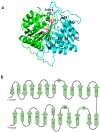Crystal Structure of a Phospholipase D from the Plant-Associated Bacteria Serratia plymuthica Strain AS9 Reveals a Unique Arrangement of Catalytic Pocket
- PMID: 33809980
- PMCID: PMC8004604
- DOI: 10.3390/ijms22063219
Crystal Structure of a Phospholipase D from the Plant-Associated Bacteria Serratia plymuthica Strain AS9 Reveals a Unique Arrangement of Catalytic Pocket
Abstract
Phospholipases D (PLDs) play important roles in different organisms and in vitro phospholipid modifications, which attract strong interests for investigation. However, the lack of PLD structural information has seriously hampered both the understanding of their structure-function relationships and the structure-based bioengineering of this enzyme. Herein, we presented the crystal structure of a PLD from the plant-associated bacteria Serratia plymuthica strain AS9 (SpPLD) at a resolution of 1.79 Å. Two classical HxKxxxxD (HKD) motifs were found in SpPLD and have shown high structural consistence with several PLDs in the same family. While comparing the structure of SpPLD with the previous resolved PLDs from the same family, several unique conformations on the C-terminus of the HKD motif were demonstrated to participate in the arrangement of the catalytic pocket of SpPLD. In SpPLD, an extented loop conformation between β9 and α9 (aa228-246) was found. Moreover, electrostatic surface potential showed that this loop region in SpPLD was positively charged while the corresponding loops in the two Streptomyces originated PLDs (PDB ID: 1F0I, 2ZE4/2ZE9) were neutral. The shortened loop between α10 and α11 (aa272-275) made the SpPLD unable to form the gate-like structure which existed specically in the two Streptomyces originated PLDs (PDB ID: 1F0I, 2ZE4/2ZE9) and functioned to stabilize the substrates. In contrast, the shortened loop conformation at this corresponding segment was more alike to several nucleases (Nuc, Zuc, mZuc, NucT) within the same family. Moreover, the loop composition between β11 and β12 was also different from the two Streptomyces originated PLDs (PDB ID: 1F0I, 2ZE4/2ZE9), which formed the entrance of the catalytic pocket and were closely related to substrate recognition. So far, SpPLD was the only structurally characterized PLD enzyme from Serratia. The structural information derived here not only helps for the understanding of the biological function of this enzyme in plant protection, but also helps for the understanding of the rational design of the mutant, with potential application in phospholipid modification.
Keywords: Serratia plymuthica strain AS9; bioinformatics; crystal structure; phospholipase D.
Conflict of interest statement
The authors declare no conflict of interest.
Figures










Similar articles
-
Plant phospholipase D mining unravels new conserved residues important for catalytic activity.Biochim Biophys Acta Mol Cell Biol Lipids. 2019 May;1864(5):688-703. doi: 10.1016/j.bbalip.2019.01.008. Epub 2019 Jan 26. Biochim Biophys Acta Mol Cell Biol Lipids. 2019. PMID: 30695732
-
Phospholipase D mechanism using Streptomyces PLD.Biochim Biophys Acta. 2009 Sep;1791(9):962-9. doi: 10.1016/j.bbalip.2009.01.020. Epub 2009 Feb 4. Biochim Biophys Acta. 2009. PMID: 19416643 Review.
-
C-terminal loop of Streptomyces phospholipase D has multiple functional roles.Protein Sci. 2007 Feb;16(2):197-207. doi: 10.1110/ps.062537907. Epub 2006 Dec 22. Protein Sci. 2007. PMID: 17189478 Free PMC article.
-
Recognition of phospholipids in Streptomyces phospholipase D.J Biol Chem. 2005 Jul 15;280(28):26143-51. doi: 10.1074/jbc.M414319200. Epub 2005 May 17. J Biol Chem. 2005. PMID: 15899903
-
Modulation of phospholipase D activity in vitro.Biochim Biophys Acta. 2009 Sep;1791(9):913-26. doi: 10.1016/j.bbalip.2009.03.003. Epub 2009 Mar 12. Biochim Biophys Acta. 2009. PMID: 19286472 Review.
Cited by
-
Structural Basis for the Regiospecificity of a Lipase from Streptomyces sp. W007.Int J Mol Sci. 2022 May 22;23(10):5822. doi: 10.3390/ijms23105822. Int J Mol Sci. 2022. PMID: 35628632 Free PMC article.
-
AI-driven drug repurposing and binding pose meta dynamics identifies novel targets for monkeypox virus.J Infect Public Health. 2023 May;16(5):799-807. doi: 10.1016/j.jiph.2023.03.007. Epub 2023 Mar 15. J Infect Public Health. 2023. PMID: 36966703 Free PMC article.
-
A New Phospholipase D from Moritella sp. JT01: Biochemical Characterization, Crystallization and Application in the Synthesis of Phosphatidic Acid.Int J Mol Sci. 2022 Oct 1;23(19):11633. doi: 10.3390/ijms231911633. Int J Mol Sci. 2022. PMID: 36232934 Free PMC article.
-
Improving Both the Thermostability and Catalytic Efficiency of Phospholipase D from Moritella sp. JT01 through Disulfide Bond Engineering Strategy.Int J Mol Sci. 2022 Sep 26;23(19):11319. doi: 10.3390/ijms231911319. Int J Mol Sci. 2022. PMID: 36232620 Free PMC article.
References
MeSH terms
Substances
Supplementary concepts
Grants and funding
LinkOut - more resources
Full Text Sources
Other Literature Sources
Miscellaneous

